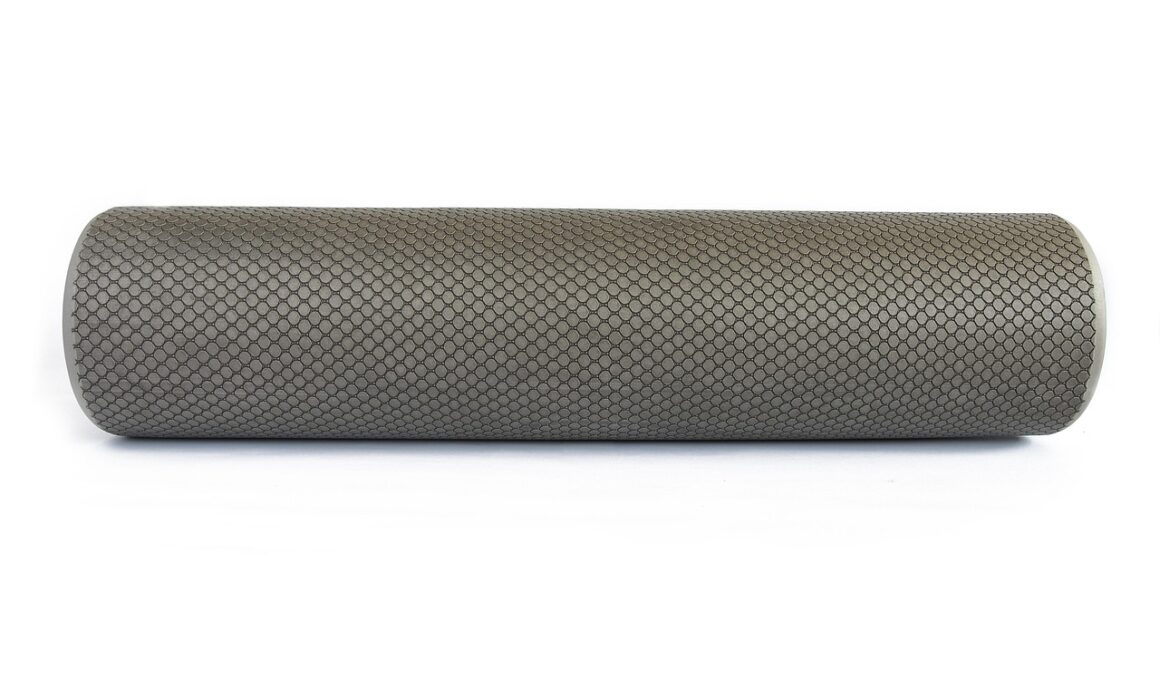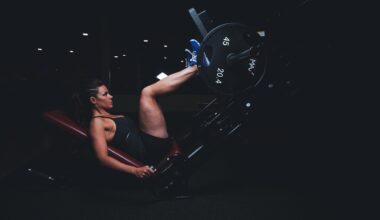Foam Rollers: Tools for Balance and Muscle Recovery
Foam rollers are essential assets in the realm of balance training and muscle recovery. These cylindrical devices come in various densities and surface textures, catering to different fitness levels and individual preferences. Foam rolling involves applying pressure to specific body parts to relieve tension, promote blood flow, and enhance flexibility. Incorporating foam rollers into your routine can significantly improve overall balance and coordination. As you engage in foam rolling, the body reacts by gentle manipulation of muscle fibers. This process helps break up adhesions and scar tissue, leading to improved muscle function. Effective muscle recovery is crucial post-exercise, particularly after strenuous activities such as weightlifting or intense cardio sessions. While foam rollers serve primarily for recovery, they can also assist in enhancing proprioception through unstable surfaces. When utilized correctly, these tools help maintain proper alignment and balance during exercise regimens. Incorporating foam rolling into your fitness routine can elevate performance and reduce the risk of injuries. For best results, dedicate time to foam roll regularly, focusing on areas that often become tight and stressed. With consistent use, foam rollers contribute to optimal balance and muscle recovery.
Understanding the various foam roller types available enhances the choice for your specific needs. When selecting foam rollers, consider variables such as size, density, and texture. Foam rollers come in different shapes and sizes, including half, full, and textured designs. Textured foam rollers often provide deeper tissue massage effects, perfect for those enduring tight muscle soreness. Conversely, smooth foam rollers are ideal for beginners who may need gentler relief. Densities range from soft to hard, affecting how deep the pressure penetrates into the muscles. New users may find softer rollers less intimidating, allowing an effective introduction to foam rolling. Meanwhile, experienced users may lean towards firmer options to obtain more profound benefits. Combining different types may yield diverse recovery outcomes, ensuring a holistic approach to injury prevention and mobility enhancement. Moreover, the versatility of foam rollers allows for use beyond aerobic or strength workouts. Balance training sessions can benefit from roller integration, developing core stability and coordination. The engagement of various muscle groups promotes an overall sense of bodily awareness, crucial for maintaining balance and preventing injuries during physical activities. Remember to check for proper techniques to maximize results and avoid harm.
Benefits of Foam Rolling for Balance
Foam rolling provides numerous benefits that extend beyond muscle recovery, particularly enhancing balance and coordination. Engaging in this practice encourages the activation of lesser-used muscle fibers, which contributes to improved proprioception. Proprioception refers to the body’s awareness of its position and movement in space, and it plays a crucial role in maintaining balance. As you roll across different muscle groups, engaging stabilizers in legs and core will enhance balance abilities. A strong core is vital for stability, and foam rolling specifically targets these crucial muscles. By applying this method regularly, individuals experience increased joint range of motion, further promoting better control during dynamic movements. Therapists recommend foam rolling before and after workouts to prepare muscles and speed up recovery. Pre-workout rolling prepares muscles for the mechanical demands ahead. On the other hand, post-workout foam rolling diminishes soreness while promoting blood circulation. Regular practice encourages muscle elasticity, highlighting a pivotal element, especially for athletes and fitness enthusiasts. With determined consistency, foam rollers can strengthen your overall balance, crucial for athletic performance as well as daily activities enhancing quality of life.
Proper technique is imperative when utilizing foam rollers to reap maximum benefits safely and effectively. Beginners should start by selecting an appropriate roller that suits their needs, fostering a sense of comfort amidst the practice. Engage in foam rolling methods covering key muscle groups, including quadriceps, hamstrings, calves, back, and glutes. A gradual approach allows your body to adapt; thus, begin with gentler techniques before progressing to varied pressures. Ensure consistent hydration before and after foam rolling sessions to aid with muscle recovery as well. Timing is also crucial; incorporating foam rolling into warm-ups or cool-downs can evoke better results during exercise routines. Devote around 30 seconds to one minute on tight muscle areas to allow adequate pressure relief. Paying attention to different muscle groups will also bolster balance improvements, as varied engagement invites additional muscle fibers to assist during balance activities. Listening to your body throughout this process is paramount. If extreme discomfort occurs, it may indicate an injury risk or incorrect technique. Monitor progress regularly and adjust as needed to sustain healthy practices over time.
Incorporating Foam Rollers into Your Routine
Effectively incorporating foam rollers into your existing training regimen can yield transformative results, targeting balance and muscle recovery. Start by recognizing specific areas of muscular tension requiring attention as you set up a flexible routine based on your preferences or training timeline. Separating sessions dedicated to foam rolling from more intense workouts may facilitate better engagement with this challenging recovery technique. They can fit well between intense training sessions during workouts, ensuring balanced muscle maintenance while minimizing strain. It becomes essential to adopt gradual integration into your routine; begin with two to three foam rolling sessions weekly for best results. The frequency can subsequently be increased based on personal recovery requirements and feedback during practice. Primary attention can initially focus on sore areas before expanding outwards to include other muscle groups. It’s important to fine-tune your technique while remaining mindful of your body’s response. As your skills improve, develop a familiarity with foam roller variations, transitioning occasionally between differing types or densities. This transition adds diversity and stimulates variety allowing you to discover optimal methods aligned with diverse training goals.
Utilizing foam rollers as part of rehabilitation programs benefits individuals recovering from injuries or surgeries. Developing balance through rehabilitation processes becomes critical to fostering healing and minimizing re-injury risks. Many physical therapists integrate foam rolling routines to accompany healing exercises. This utility extends to providing relief for tight muscles, which may hinder movement and coordination. Identifying particular muscle groups that experience discomfort encourages more focused rehabilitation avenues. Enhancing muscle recovery leads to fruitful rebuilding efforts while aiming for restored balance post-injury. As clients progress through various rehabilitation stages, foam rolling can adjust to specified needs; for instance, using softer rollers to enhance comfort initially. As patients advance, transitioning towards denser options encourages muscle engagement that rehabilitates and strengthens affected areas. Including roller sessions post-activity enriches recovery, thereby creating a conducive environment for improved muscle elasticity as well. Your therapist may recommend appropriate techniques to explore alongside foam rolling for intricate rehabilitation systems tailored to individual capacities. This method not only expedites recovery but also enhances balance, readiness for activity, and successful return to sports and daily routines.
Conclusion: Embracing Foam Rollers for Balance Training
Ultimately, embracing foam rollers within balance training routines dedicates emphasis on muscle recovery, performance, and injury prevention. The myriad benefits derived from consistent practice prompt significant improvements in physical capabilities, particularly relating to balance and coordination. Users experience muscular awareness, enhanced flexibility, and improved qualitative movements across numerous physical settings. Furthermore, the cross-functional elements gained from foam rolling enable athletes to achieve higher performance levels while enjoying injury prevention during engaging activities. Adopting foam rollers creates opportunities for deeper connections within muscle systems, ensuring better alignment in core-based movements functionality. As you engage in foam rolling, the relationship between stability and muscle recovery thrives harmoniously, fostering optimal performance in daily endeavors. Emphasizing strategies with foam rollers can teach athletes about their body mechanics while enhancing their balance capabilities over time. You may find yourself asking how you ever trained without a foam roller, understanding their critical role within successful fitness journeys. Invest time to practice regularly and assess personal progress while staying mindful of your varying needs. In conclusion, foam rollers serve as invaluable tools for anyone seeking optimal muscle recovery and superior balance capabilities.


